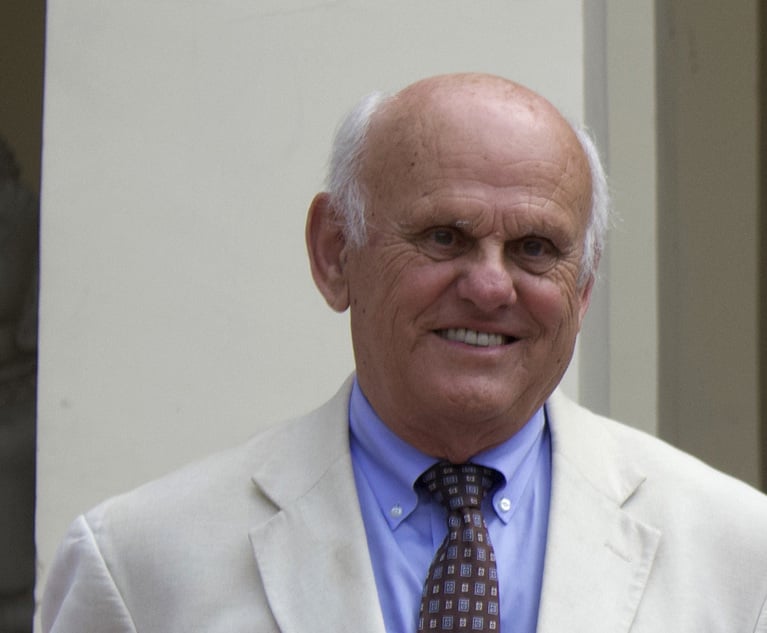Inside Unsealed Documents in Microsoft Gender Discrimination Case
Newly unsealed court papers in a gender discrimination case against Microsoft open a window into how one company has confronted workplace allegations of disparate treatment.
March 13, 2018 at 06:15 PM
7 minute read
 Microsoft headquarters in Redmond, Washington
Microsoft headquarters in Redmond, Washington
Microsoft Inc.'s internal investigation process resulted in one “founded” case of gender discrimination out of 118 complaints filed over a six-year span, according to documents unsealed Monday in a closely watched case in Seattle federal court.
Lawyers representing current and former female technical employees contend the low return supports arguments alleging Microsoft has a history of “lackluster” responses to investigating complaints. The company, rebutting the claims, reported robust training and millions of dollars spent annually on diversity efforts.
The case against the Redmond, Washington-based tech company claims systemic practices across offices created a disparity for advancement and equal pay for women in engineering and technical roles compared to men. Lawyers for the plaintiffs reported in court documents a toxic boy's club atmosphere, which include reports of sexual assault and retaliation. The complaint is pending class certification as the plaintiffs say 8,600 female employees could comprise the class.
Questions about how companies handle claims of sexual harassment have risen to greater importance in the #MeToo movement. Businesses are looking inward about whether policies protect women from persistent patterns of harassment.
“This is one of the oldest and most venerable companies in the tech space,” said Anne Shaver of Lieff, Cabraser, Heimann & Bernstein, a lead attorney for the female Microsoft employees. “My sense is that this case is being watched as a talisman: Can companies still be held accountable for discrimination in a class action?” The firm Outten & Golden also represent the women.
Microsoft is represented by a team from Orrick, Herrington & Sutcliffe.
A company representative said in a statement, “Diversity and inclusion are critically important to Microsoft. We want employees to speak up if they have concerns and we strive to make it easy for them to do so. We take all employee concerns seriously and have a fair and robust system in place to investigate employee concerns and take appropriate action when necessary.”
Here are some highlights from the hundreds of unsealed documents, depositions and expert testimony released this week:
How female technical workers say complaints were handled.
Between 2010 and 2016, Microsoft received 108 complaints of sexual harassment from female technical employees. During the time, female employees lodged 118 complaints of gender discrimination, eight complaints of retaliation and three complaints of pregnancy discrimination. “What is even more disappointing is the lackluster response to the issues raised by the Microsoft team tasked with investigating complaints of Microsoft's anti-discrimination and anti-harassment policy,” according to the plaintiffs' motion to certify the class. The redacted copy of the document was unsealed on March 12.
The motion claims the company's internal investigation process is notorious among employees for “rubber-stamping” management, and employees have “little faith” in the investigations. In a deposition, one employee said, “I have no idea whether HR investigated my complained, as HR never followed up. I believe that complaining to HR can be career-ending at Microsoft and I only did so because I saw no other option short of leaving the company, which I did when HR did nothing.” In another case, an employee said, “HR ignored multiple complaints of discrimination, including when [a] manager explicitly stated he denied her a promotion because he did not want to waste it on someone who might become pregnant.” Another said, “After complaining that male co-workers with less experience were earning more, 'HR told me there was nothing they could do.'”
The company said that even where there was no “policy violation” deemed founded, the company took action such as providing coaching or training.
Microsoft's HR policies fail employees, the plaintiffs lawyers claim.
Attorneys for the female employees argued the company's internal investigators often conclude there is no “policy violation,” despite alleged evidence to the contrary. The plaintiffs' papers pointed to four female employees who raised separate complaints of sexual harassment against a male employee at a Microsoft event. There was no policy violation in that case. The plaintiffs lawyers contend Microsoft lacks policies and procedures for employees who allege sexual assault, noting two women raised complaints against a male employee who was left alone on-site with them.
Female employees contend they would fear reprisal, the plaintiffs attorneys said, for reporting claims. One reported that her manager cautioned her against putting claims in writing because she would likely be terminated and another said she received her first negative performance review after complaining about gender discrimination at a women's event.
“In 2013, counsel representing employees in an earlier systemic gender bias investigation suggested that Microsoft implement 'mandatory training for all managers on the EEO complaint handling process.' Microsoft declined to do so,” the plaintiffs lawyers argued.
Microsoft trumpets the company's investment in equal protections.
The company's opposition to the motion to certify the class, unsealed March 12, stated: “In over twenty years of committed diversity and inclusion efforts, Microsoft has learned that diversity is not a finite goal, but a process that requires constant self-assessment and re-commitment. Microsoft is keenly aware of the gender imbalance in the tech industry and is deeply invested in improving it.” Microsoft's papers trumpet how the company invests in ways to promote equal protections.
In a declaration, Microsoft executive Shinder Dhillon, senior director of global diversity and inclusion for engineering and corporate functions, said the company has invested tens of millions of dollars to create a more inclusive culture, retain diverse talent and ensure equal pay and opportunity.
Dhillon said Microsoft's budget for diversity and inclusion was $13.4 million in 2015 and the company budgeted to increase its spending to $55.4 million a year through 2020. The company said the plaintiffs' efforts fall short of proving the standards necessary for a class action.
“Microsoft has a team of full-time investigators to consider allegations of policy violations and mandates diversity training for all employees. Plaintiffs' hearsay anecdotes (most from non-class members), even if true, do not qualify as 'significant proof' of 'a general policy of discrimination,'” according to Microsoft's court papers. “Their claims and the absent class members' claims will not rise or fall together—the hallmark of typicality.”
Microsoft's policies are “robust and sound,” one expert for the company says.
Microsoft's court papers point to the company's recent decision to waive the contractual requirement for arbitration of sexual harassment claims. “The easiest mistake any employer can make is to assume that 'this could never happen here.' While it's natural to hope and believe that's the case, one of the fundamental lessons of recent months is that people's voices need to be heard if their problems are to be addressed,” Brad Smith, Microsoft's president and chief legal officer, said in December.
The company also submitted in the case expert testimony from HR consultant Rhoma Young that found the Microsoft processes for employee concerns are “robust and sound” and HR's “background are much more expansive than what I usually see in other organizations.”
Young concluded the internal investigators are “not trying to minimize or ignore problems or minimize potential liability. They want to find them (possible problems) out early so they can address and identify and resolve them.” The plaintiffs' expert in response—Caren B. Goldberg, an associate professor of management at Bowie State University—said Young's report was not based on any scientific method and that the analysis was not credible.
Read more:
Fighting Class Action, Microsoft Acknowledges Gender Imbalances in Tech Industry
Microsoft, Nodding to '#MeToo,' Says It Won't Keep Harassment Victims Out of Court
Workplace 'Love Contracts' Draw Renewed Focus in #MeToo Era
HR's #MeToo Dilemma: How Much to Say About That Fired Employee?
This content has been archived. It is available through our partners, LexisNexis® and Bloomberg Law.
To view this content, please continue to their sites.
Not a Lexis Subscriber?
Subscribe Now
Not a Bloomberg Law Subscriber?
Subscribe Now
NOT FOR REPRINT
© 2025 ALM Global, LLC, All Rights Reserved. Request academic re-use from www.copyright.com. All other uses, submit a request to [email protected]. For more information visit Asset & Logo Licensing.
You Might Like
View All
'Where Were the Lawyers?' Judge Blocks Trump's Birthright Citizenship Order
3 minute read
Netflix Music Guru Becomes First GC of Startup Helping Independent Artists Monetize Catalogs
2 minute read
K&L Gates Files String of Suits Against Electronics Manufacturer's Competitors, Brightness Misrepresentations
3 minute read
Holland & Knight Hires Former Davis Wright Tremaine Managing Partner in Seattle
3 minute readTrending Stories
- 1Gibbons Reps Asylum Seekers in $6M Suit Over 2018 ‘Inhumane’ Immigration Policy
- 2DC Judge Chutkan Allows Jenner's $8M Unpaid Legal Fees Lawsuit to Proceed Against Sierra Leone
- 3Internal Whistleblowing Surged Globally in 2024, so Why Were US Numbers Flat?
- 4In Resolved Lawsuit, Jim Walden Alleged 'Retaliatory' Silencing by X of His Personal Social Media Account
- 5Government Attorneys Face Reassignment, Rescinded Job Offers in First Days of Trump Administration
Who Got The Work
J. Brugh Lower of Gibbons has entered an appearance for industrial equipment supplier Devco Corporation in a pending trademark infringement lawsuit. The suit, accusing the defendant of selling knock-off Graco products, was filed Dec. 18 in New Jersey District Court by Rivkin Radler on behalf of Graco Inc. and Graco Minnesota. The case, assigned to U.S. District Judge Zahid N. Quraishi, is 3:24-cv-11294, Graco Inc. et al v. Devco Corporation.
Who Got The Work
Rebecca Maller-Stein and Kent A. Yalowitz of Arnold & Porter Kaye Scholer have entered their appearances for Hanaco Venture Capital and its executives, Lior Prosor and David Frankel, in a pending securities lawsuit. The action, filed on Dec. 24 in New York Southern District Court by Zell, Aron & Co. on behalf of Goldeneye Advisors, accuses the defendants of negligently and fraudulently managing the plaintiff's $1 million investment. The case, assigned to U.S. District Judge Vernon S. Broderick, is 1:24-cv-09918, Goldeneye Advisors, LLC v. Hanaco Venture Capital, Ltd. et al.
Who Got The Work
Attorneys from A&O Shearman has stepped in as defense counsel for Toronto-Dominion Bank and other defendants in a pending securities class action. The suit, filed Dec. 11 in New York Southern District Court by Bleichmar Fonti & Auld, accuses the defendants of concealing the bank's 'pervasive' deficiencies in regards to its compliance with the Bank Secrecy Act and the quality of its anti-money laundering controls. The case, assigned to U.S. District Judge Arun Subramanian, is 1:24-cv-09445, Gonzalez v. The Toronto-Dominion Bank et al.
Who Got The Work
Crown Castle International, a Pennsylvania company providing shared communications infrastructure, has turned to Luke D. Wolf of Gordon Rees Scully Mansukhani to fend off a pending breach-of-contract lawsuit. The court action, filed Nov. 25 in Michigan Eastern District Court by Hooper Hathaway PC on behalf of The Town Residences LLC, accuses Crown Castle of failing to transfer approximately $30,000 in utility payments from T-Mobile in breach of a roof-top lease and assignment agreement. The case, assigned to U.S. District Judge Susan K. Declercq, is 2:24-cv-13131, The Town Residences LLC v. T-Mobile US, Inc. et al.
Who Got The Work
Wilfred P. Coronato and Daniel M. Schwartz of McCarter & English have stepped in as defense counsel to Electrolux Home Products Inc. in a pending product liability lawsuit. The court action, filed Nov. 26 in New York Eastern District Court by Poulos Lopiccolo PC and Nagel Rice LLP on behalf of David Stern, alleges that the defendant's refrigerators’ drawers and shelving repeatedly break and fall apart within months after purchase. The case, assigned to U.S. District Judge Joan M. Azrack, is 2:24-cv-08204, Stern v. Electrolux Home Products, Inc.
Featured Firms
Law Offices of Gary Martin Hays & Associates, P.C.
(470) 294-1674
Law Offices of Mark E. Salomone
(857) 444-6468
Smith & Hassler
(713) 739-1250






